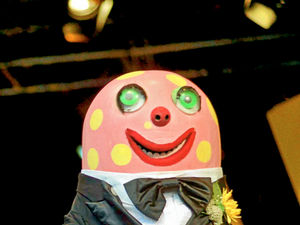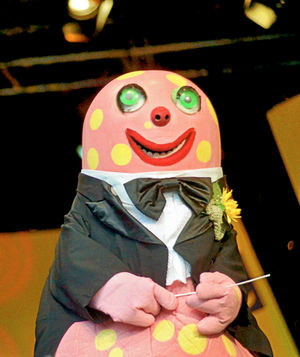No barrel un-scraped in Saturday ratings fight
An unidentified celebrity walks on stage dressed as a pharoah, and belts out a horribly off-key version of the Bangles’ hit Walk Like An Egyptian.

A celebrity judging panel unsuccessfully tries to guess the identity of the tone-deaf performer, before he is eventually identified as... former home secretary Alan Johnson. That’s Saturday night television for you.
The Masked Singer, which made its debut at the weekend, is the latest in a long line of off-the-wall programmes to be screened on a Saturday night. Some, such as Celebrity Wipeout, became massive hits, others sank without trace.
But one thing is for sure – when it comes to gaining a competitive edge in the prime-time ratings war, there are few gimmicks TV executives will not try.
“You often wonder how they come up with these ideas,” says West Midlands TV historian Chris Perry. “I saw the trailers for The Masked Singer and thought ‘that looks a very weird show’.”
But probably not as weird as Sin on Saturday, which must surely go down as one of the strangest – and most ill-judged – television programmes ever to be made.
Probably a dig at celebrity hymn-singing show Stars on Sunday, the series was commissioned for eight weeks in the summer of 1982 to fill the slot vacated by Michael Parkinson.
Spice
Hosted by Nationwide newscaster Bernard Falk, each live episode focused on one of the Seven Deadly Sins, with the final episode dedicated to an eighth – getting away with it.
The first edition began with Robbie Coltrane performing a monologue as spoof American psychiatrist Prof Tom Martin, arguing why lust is good for you, before moving onto ‘topical debate’ with porn star Linda Lovelace, a lapsed nun and a drunken Oliver Reed.
Adding a bit of spice to the proceedings was the studio audience including Salvation Army members, a prostitute, scantily clad beauty queens and a topless fire-eater. The performance was topped off by interventions by the spoof uptight moral guardian Mitzy Volderbeast from Pretoria. You really didn’t need to be Mary Whitehouse to find this a bit tacky, but it was Reed’s boorish behaviour which probably sealed its fate.
“You could see right from the beginning that it wasn’t going to go well,” says Chris, founder of TV archive Kaleidoscope. The series was pulled after three episodes.
“It was written by a lot of comedy writers, but it just wasn’t right for Saturday night. You do wonder what they were thinking of.”

One of the reasons these oddball programmes slip through the net is the growing trend for commissioners to look for successful formats from overseas. The Masked Singer, based on a format from South Korea, is a case in point.
“They think if a show is a success in South Korea, it will be a success in the UK, but tastes can be very different,” says Chris.
Sometimes it works. Yorkshire Television’s 3-2-1, based on a Spanish quiz show, was intended as a one-off summer filler when it was launched in 1978. On paper, it sounded a very strange combination: a conventional general knowledge quiz, some dubious music-hall entertainment, coupled with a series of impossibly difficult cryptic clues and a dancing dustbin – yet somehow it worked, pulling in up to 16.5 million viewers over the next decade.
The Price Is Right, based on a long-running American series, achieved similar success. It probably seems strange today how grown adults would work themselves into a frenzy because they had a one-in-five chance of winning a toaster, but the show – fronted by an energetic Leslie Crowther – was perfect for the consumer-driven 1980s.
Prank shows are a popular staple for TV commissioners, and with Jeremy Beadle the king of the genre in the 1980s. His first show Game For A Laugh, saw practical jokes played on both members of the audience and the general public, although some aspects were decidedly tacky.
Cheese
Audience members’ willingness to take part in a challenge – where failure to complete the task resulted in them being smacked in the face with a custard pie by a mechanical arm – perhaps highlights how some people will do anything to appear on TV.
Beadle followed it up by the more conventional, Candid Camera style Beadle’s About, which certainly featured some memorable moments – the face of the car-wash operator who watched in disbelief as a line of cars, all painted with water-based paint, changing colour before his very eyes was very memorable. So too was the cross-channel ferry passenger remonstrating with a heavily disguised Beadle about how is car had been stolen in the middle of the sea. But by the 1990s the format was becoming stale.
Perhaps the king of madcap Saturday night antics is Noel Edmonds, an ever-present face in the 1980s and 1990s with Late, Late Breakfast Show, Noel Edmonds’ Saturday Roadshow, and finally Noel’s House Party. The latter was in many ways a rehash of Game For A Laugh, but with generous helpings of cheese that only Edmonds could deliver. Featuring the host as the supposed squire of the Crinkly Bottom mansion, it relied on the gunge tank and the inflatable rubber Mr Blobby to add a dash of sophistication to the format.
While it is unlikely to go down as a great moment in TV history, Noel’s House Party was hugely successful, and Mr Blobby famously beat Take That for the Christmas No. 1 – with lyrics which even the show’s target audience would find easy to remember.




